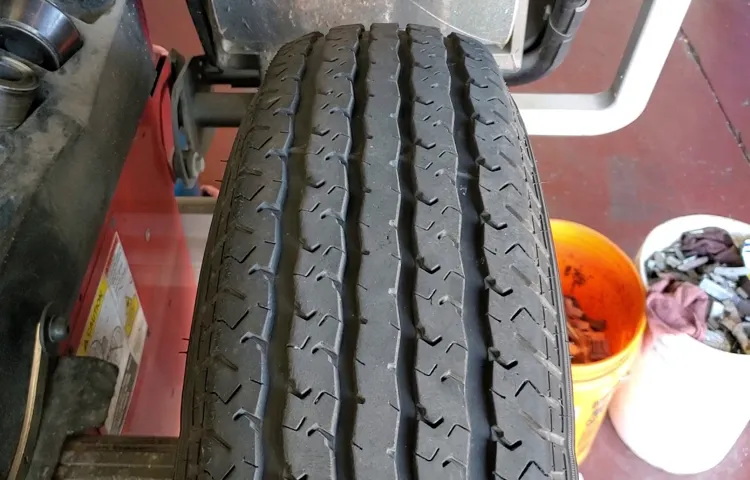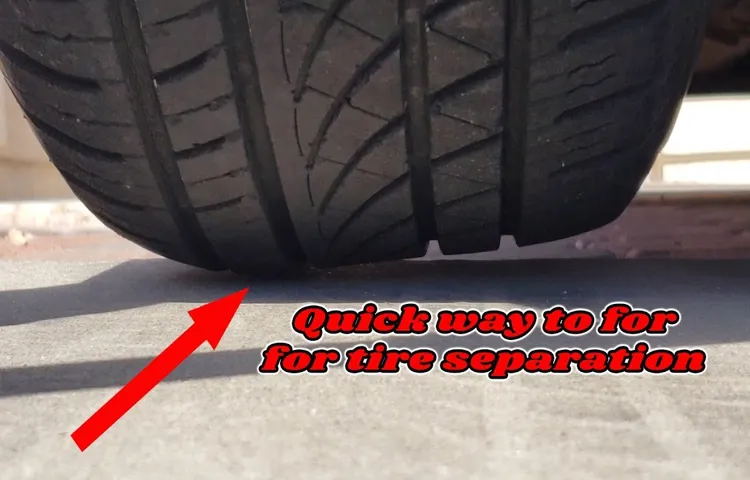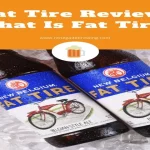Have you ever driven on a separated tire before? It’s not a comfortable experience, to say the least. The feeling can be best described as a wobbling or shaking sensation, as if the car is struggling to maintain its balance. Depending on the severity of the separation, the shaking can range from mild to violent.
It’s akin to driving a car with a broken axle, only the problem is isolated to the tire itself. Imagine trying to balance a spinning top that’s started to wobble off-center. The top begins to shake violently as it loses its balance.
That’s what it’s like driving on a separated tire. The tire loses its structural integrity, and the car starts to wobble. It’s not just a matter of discomfort; it can also be incredibly dangerous.
A separated tire decreases the amount of control you have over the car and greatly increases the likelihood of an accident. In this blog, we’ll dive deeper into what causes tire separation and how to prevent it from happening. We’ll also delve into the ways that tire separation affects your vehicle and what you should do if you suspect your tire has separated.
Table of Contents
Causes Of Tire Separation
If you’ve ever experienced a separated tire, you’ll know it’s a terrifying and potentially deadly experience. A separated tire feels like you’re losing control of your vehicle, and the vibration and noise can be jarring. This separation occurs when the layers of the tire’s construction come apart, causing the tire to lose its shape and balance.
Most often, the cause of tire separation is due to age and wear. Over time, the rubber begins to break down, causing the tire to lose flexibility and strength. Other causes may be from driving on underinflated tires or overweight vehicles, which put additional stress on the tire.
It’s important to regularly inspect your tires for any signs of wear, damage or bulges, making sure your tire pressure is correct and that you’re using properly rated tires. If you ever feel like you’re experiencing a separated tire, it’s critical to remain calm and focus on safely bringing your vehicle to a stop.
Overheating
Tire separation is a common issue that many drivers may face while on the road. One of the main causes of tire separation is overheating. When a tire gets too hot, the internal components can start to break down, leading to damage and eventually separation.
This can happen due to a number of reasons, such as driving at high speeds for long periods of time, underinflated tires, or overloading the vehicle. It’s important to regularly check your tire pressure and follow the manufacturer’s recommendations for maximum load capacity to avoid overheating and potential tire separation. So next time you hit the road, make sure to check your tires and keep them at the proper pressure to prevent any unexpected mishaps.

Worn Tires
One of the main causes of tire separation is worn tires. As tires age, the rubber becomes brittle and can crack, leading to weak spots in the tire. These weak spots can cause the tire to separate and lead to a blowout while driving.
Additionally, worn tires can be more susceptible to punctures and other damage, which can also lead to tire separation. It is essential to regularly check the condition of your tires and replace them when they start showing signs of wear. Don’t wait until it’s too late and always make sure to choose tires that are appropriate for your vehicle and driving conditions.
By maintaining your tires properly, you can reduce the risk of tire separation and keep yourself and your passengers safe on the road.
Signs Of Tire Separation
If you’re driving down the road and you feel a strange vibration or hear a thumping noise, it could be a sign of tire separation. This occurs when the layers of a tire start to come apart, often due to normal wear and tear or an impact with a pothole or curb. What does a separated tire feel like? It can vary, but some common signs include a rough or bumpy ride, difficulty controlling the vehicle, or a noticeable bulge in the tire.
It’s important to address any warning signs of tire separation immediately, as driving on a separated tire can be extremely dangerous and increase the risk of a blowout on the road. Regular inspections and maintenance can help prevent tire separation and keep you and your passengers safe on the road.
Vibration
Vibration Driving on the road can become even more jarring when you start to feel a persistent vibration. It’s a common indication that something is wrong with your vehicle. In the case of tire separation, you’ll feel a particular type of vibration.
You’re driving down the road, everything seems fine, but then you start to feel a wobbling motion. Sometimes this is accompanied by a humming noise. It’s a sign that your tire may have separated, and it’s time to pull over and check things out.
It’s important not to keep driving once you feel this type of vibration because it can be dangerous. Tire separation occurs when the different components of the tire start to come apart, causing the tire to deform. It’s usually caused by factors such as inadequate maintenance, overloading, or underinflation.
In any case, if you notice persistent vibrations, it’s better to get your tires checked out by a professional.
Uneven Tread Wear
Uneven tread wear on your tires is usually the first sign of tire separation. As the tread on your tire wears unevenly, it can result in bulges or bubbles, which could lead to a tire blowout while driving. These bulges occur when the steel belts inside the tire start to separate from the rubber or when the internal structure of the tire is damaged.
If you notice any bumps, bulges, or bubbles on the sidewall of your tire, it’s crucial to have it checked by a professional mechanic immediately. Regular inspection and proper maintenance of your tires can help prevent tire separation and ensure your safety while on the road. Remember, your tires are the only contact between your vehicle and the road, so it’s essential to keep them in good condition to avoid any accidents.
So, take good care of your tires, and they’ll take good care of you.
Bulging In The Sidewall
If you notice a bulging in the sidewall of your tire, it could be a sign of tire separation. Tire separation is a serious issue that can put you and your passengers at risk. Tire separation occurs when the tread separates from the rest of the tire, causing the tire to lose its shape and become unsafe to drive on.
If you continue to drive on a tire that is experiencing separation, it could eventually lead to a blowout, which could be catastrophic. To prevent tire separation, it is essential to regularly inspect your tires for any signs of wear or damage. If you notice bulging in the sidewall or any other signs of tire separation, it’s essential to have your tire inspected by a professional immediately.
Remember, your safety is at stake, and taking immediate action is crucial.
What It Feels Like To Drive On A Separated Tire?
Have you ever experienced driving on a separated tire? It can be a pretty scary experience. A separated tire occurs when the tread separates from the rest of the tire, and it can cause a loud thumping sound as you drive. You may also feel a vibration or shaking sensation through the steering wheel or even the entire vehicle.
It’s important to immediately pull over to examine the tire because trying to continue driving on a separated tire can be dangerous. The longer you continue to drive on it, the higher the chance of a blowout, which could lead to a loss of control of the vehicle and even a serious accident. So, if you ever feel any kind of vibration or hear any strange noises while driving, it’s always best to play it safe and have your tires checked by a professional mechanic.
Loss Of Control
When driving on a separated tire, it can feel like you’ve lost complete control of your vehicle. The steering wheel may pull strongly to one side, and it can be challenging to keep it on course. The car may also vibrate or shake, and you may hear odd noises coming from the wheel well.
The experience can be unnerving, causing panic and stress as you try to avoid losing control and getting into an accident. You may have to slow down or pull over to the side of the road, which can be particularly dangerous if you’re on a highway or busy road. In any case, if you suspect you have a separated tire, it’s crucial to get it fixed as soon as possible to avoid potential accidents or further damage to your vehicle.
Don’t risk your safety or that of others on the road. Get your tire repaired or replaced right away.
Rough And Unstable Ride
Driving on a separated tire can be a rough and unstable ride. It feels like your car is constantly wobbling and bouncing. Every bump in the road feels exaggerated, and it becomes harder to control your vehicle’s steering.
It’s like trying to balance on one foot while walking on a tightrope – nearly impossible. The uneven weight distribution makes your car harder to handle, and it puts immense strain on your other tires, leading to further driving problems. It’s important to address a separated tire immediately because it poses a severe safety hazard.
Not only does driving on it put you in danger, but it also puts everyone else on the road at risk. So, if you feel like your car is acting abnormally, pull over and inspect your tires. It’s better to be proactive than to put yourself and others in harm’s way.
Difficulty Steering
Driving on a separated tire can be an unnerving experience. One of the most notable signs of a separated tire is difficulty steering. If you’re driving and notice that the steering wheel feels loose or is pulling to one side, it may indicate that you’re dealing with a separated tire.
It can be particularly challenging to maintain control of your vehicle when this happens, especially at higher speeds. You may also notice that your car doesn’t handle or respond as quickly as it normally does. So if you’re experiencing any of these symptoms, it’s best to pull over as soon as possible and check your tires.
Driving on a separated tire is not only dangerous but can also lead to further damage to your vehicle. Don’t take any chances, and get your tires checked by a professional mechanic.
What To Do If You Suspect Tire Separation?
If you suspect tire separation while driving, you may experience a sudden thumping or vibration that can be felt throughout the steering wheel, floorboards, or seat. This may be accompanied by a loud banging or flapping noise, as well as a loss of control or difficulty steering. Additionally, you may notice the affected tire appears saggy or misshapen, with visible cracks or bulges on the sidewall.
In such a situation, it’s essential to maintain calm and immediately slow down and pull over to a safe spot on the side of the road. Continuing to drive on a separated tire can cause further damage to your vehicle, as well as increase your risk of a blowout or accident. Once stopped, inspect the tire for any signs of separation or other damage, and call for professional assistance if necessary.
Regular tire maintenance and inspection can help prevent tire separation, so it’s important to stay on top of such tasks.
Slow Down And Pull Over Immediately
If you suspect that your tire is experiencing separation, the first thing you should do is slow down and pull over immediately. Tire separation happens when the steel belts under the tread separate from the rubber, leading to a loss of air pressure and potentially causing a blowout. This can be dangerous, especially if you’re driving at high speeds.
Once you pull over, do a visual inspection of the tire. Look for uneven wear, bulges, or areas where the rubber has separated from the steel belts. If you see any of these signs, it’s best to replace the tire as soon as possible.
Don’t try to drive on it, as this can cause further damage and lead to an even more dangerous situation. As a general rule, it’s a good idea to check your tires regularly for signs of wear and tear. This can help you catch any issues early on and avoid a potential blowout on the road.
Inspect Your Tires For Damage
Inspecting your tires for damage is essential to ensure safety on the road. One of the most common issues associated with tires is tire separation, which can lead to a blowout or loss of control. If you suspect that your tire has separated or is in the process of separating, it’s crucial to take immediate action.
Pull over to a safe spot and assess the situation. If the tire is still holding air, you may be able to drive slowly to a repair shop – but a tire separation is often an emergency. Do not attempt to keep driving on the tire, as this can lead to further damage to both the tire and your vehicle.
Instead, call for roadside assistance or have your vehicle towed to a nearby tire service center. By taking prompt action, you can help prevent a potentially dangerous situation from causing harm to yourself and others on the road. So take the time to inspect your tires regularly, and be prepared to act quickly if you suspect a problem like tire separation.
Get Professional Help
If you suspect tire separation, it’s important to get professional help right away. Don’t try to diagnose or fix the problem yourself. Tire separation can occur when the tire’s metal cords separate from each other or from the rubber casing, which can result in a dangerous blowout.
This can happen due to age, wear and tear, or improper inflation. If you notice any signs of tire separation, such as a bulge or bubble on the tire, vibration while driving, or a change in steering or handling, it’s crucial to have your vehicle inspected by a professional immediately. This will help ensure your safety on the road and prevent further damage to your vehicle.
Remember, taking care of your tires is an important part of maintaining your vehicle’s overall health and longevity.
Conclusion
After experiencing a separated tire, one might describe it as akin to driving a unicycle juggling flaming knives – it’s definitely not something you want to encounter on the road. The feeling of a tire separating is a combination of a sudden loss of control, a disorienting thump, and possibly some colorful language. It serves as a reminder that tires are the only thing connecting our vehicles to the road, and it’s vital to keep them properly maintained and inspected.
So, next time you’re on the road, keep an eye out for any wobbles or strange vibrations – because a separated tire is definitely not a fun ride.”
FAQs
How can I tell if my tire is separated?
You may feel a vibration or shimmy in the steering wheel while driving, or notice uneven wear on the tire itself. Additionally, you may see bulges or cracks in the tire.
Is it safe to drive with a separated tire?
No, it is not safe to continue driving on a separated tire. It can cause loss of control and potentially a dangerous situation on the road.
What causes a tire to separate?
Tire separation can be caused by a variety of factors, including underinflation, overloading, and manufacturing defects.
Can a separated tire be repaired?
No, a separated tire cannot be repaired. It must be replaced.
How often should I check my tires for separation?
It is recommended to check your tires for separation at least once a month, and before any long road trips.
What should I do if I suspect my tire is separated?
Immediately pull over to a safe location and inspect the tire. Do not continue driving on a separated tire.
How can I prevent tire separation?
Regularly check and maintain proper tire pressure, avoid overloading your vehicle, and inspect your tires for any signs of damage or wear.


